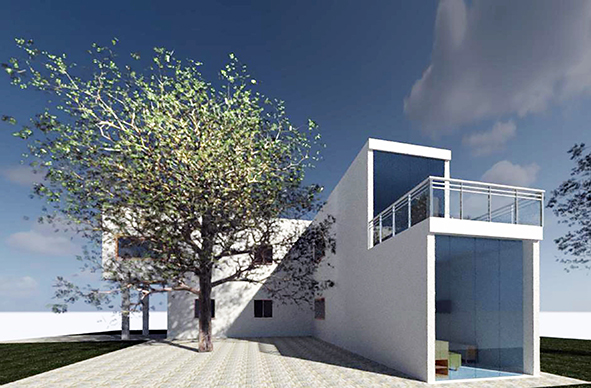Building Industrialization and Prefabrication between Materiality and Immateriality
DOI:
https://doi.org/10.19229/2464-9309/5102019Keywords:
BIM, digital fabrication, file to factory, lean production, off-site manufacturingAbstract
This paper aims to investigate the possibilities offered by the design and production paradigms of Industry 4.0 in the Architecture, Engineering & Construction industry, through the coordination between systems for the integrated management of the design process (Building Information Modeling) and rapid prototyping tools (Computer-Aided Manufacturing). Is hereby proposed an interpretation of the meaning that an industrial transformation of the AEC industry takes over for the Architectural design, simulating a methodology in a BIM environment for the design of residential buildings in Cold-Formed Steel with drywall envelopes, exploiting the potential of digital manufacturing and computational design advanced tools.
Downloads
Article Metrics Graph
References
Albus, J. and Meuser, P. (2017), Prefabricated Housing – Construction and Design Manual, Dom. Pub., Berlin.
ANCE – Associazione Nazionale Costruttori Edili (2016), Una politica industriale per il settore delle costruzioni – Le proposte dell’ANCE. [Online] Available at: www.ance.it [Accessed 10 April 2019].
Anderson, C. (2013), Makers – The new industrial revolution, Random House, New York.
Bacigalupi, V. et alii (1978), Edilizia per progetti e componenti, Officina Edizioni, Roma.
Barucco, M. (2015), Progettare e costruire in acciaio sagomato a freddo, Edicom, Monfalcone.
Campioli, A. (1992), I presagi di un nuovo costruire – Il linguaggio delle tecniche esecutive nell’architettura della seconda età della macchina, Franco Angeli, Milano.
Ciribini, A. (2016), BIM e digitalizzazione dell’ambiente costruito, Grafill, Palermo.
Davies, C. (2005), The Prefabricated Home, Reaktion Books, London.
Dunn, N. (2012), Digital fabrication in Architecture, Laurence King Publishing, London.
Frazer, J. (1995), An Evolutionary Architecture, AA Press, London.
Garber, R. (2014), BIM Design – Realising the creative potential of Building Information Modelling, John Wiley & Sons, New Jersey.
Gramazio, F., Kohler, M. and Willmann, J. (2014), The Robotic Touch – How Robots Change Architecture, Park Books, Zurich.
Iwamoto, L. (2009), Digital Fabrications – Architectural and material techniques, Princeton Architectural Press, New York.
Kieran, S. and Timberlake, J. (2004), Refabricating architecture – How manufacturing methodologies are poised to transform building construction, McGraw Hill, New York.
Landolfo, R. and Russo Ermolli, S. (2012), Acciaio e sostenibilità – Progetto, ricerca e sperimentazione per l’housing in cold-formed steel, Clean, Napoli.
Marsh, P. (2013) The new industrial revolution – Consumers, globalization and the end of mass production, Yale University Press, Padstow, Cornwall.
McKinsey Global Institute (2016), Imagining construction’s digital future. [Online] Available at: www.mckinsey.com/industries/capital-projects-and-infrastructure/our-insights/imagining-constructions-digital-future [Accessed 10 April 2019].
Nardi, G. (1981), Tecnologia dell’architettura e industrializzazione nell’edilizia, Franco Angeli, Milano.
National Building Standard (2018), Four phases of industrial revolution – Phase Four. [Online] Available at: www.thenbs.com/knowledge/four-phases-of-industrial-revolution-phase-four [Accessed 10 April 2019].
Negroponte, N. (2010), “Towards a new Humanism through machines”, in Menges, A. and Alquist, S. (eds), Computational Design Thinking, AD Reader series, John Wiley & Sons, New Jersey.
Poretti, S. (2013), “Un’industrializzazione sfasata”, in Basiricò, T. and Bertorotta, S. (eds), L’industrializzazione nei quartieri di edilizia residenziale pubblica, Aracne, Roma.
Reiser, J. and Umemoto, N. (2006), Atlas of novel tectonics, Princeton Press, New York.
Russo Ermolli, S. (ed.) (2018), The Changing Architect – Innovazione tecnologica e modellazione informativa per l’efficienza dei processi, Maggioli, Santarcangelo di Romagna.
Smith, R. E. and Quale, J. D. (2017), Offsite Architecture – Constructing the future, Routledge, London/New York.

Downloads
Published
How to Cite
Issue
Section
License
This Journal is published under Creative Commons Attribution Licence 4.0 (CC-BY).
License scheme | Legal code
This License allows anyone to:
Share: copy and redistribute the material in any medium or format.
Adapt: remix, transform, and build upon the material for any purpose, even commercially.
Under the following terms
Attribution: Users must give appropriate credit, provide a link to the license, and indicate if changes were made; users may do so in any reasonable manner, but not in any way that suggests the licensor endorses them or their use.
No additional restrictions: Users may not apply legal terms or technological measures that legally restrict others from doing anything the license permits.
Notices
Users do not have to comply with the license for elements of the material in the public domain or where your use is permitted by an applicable exception or limitation.
No warranties are given. The license may not give users all of the permissions necessary for their intended use. For example, other rights such as publicity, privacy, or moral rights may limit how you use the material.


















































































